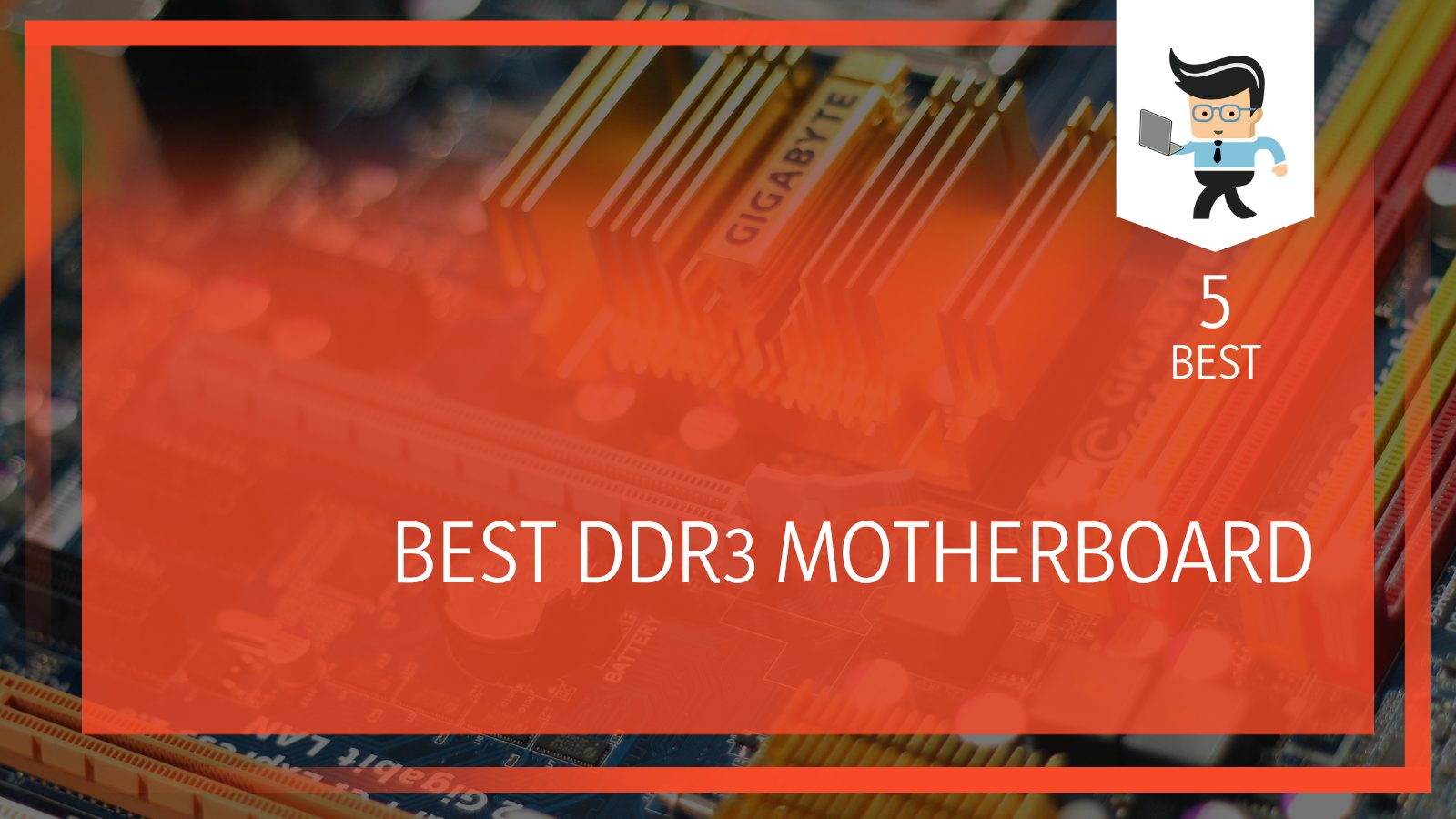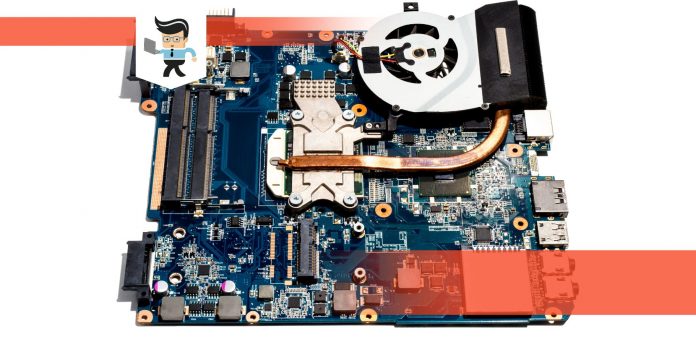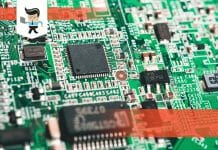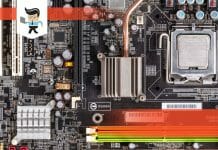The best DDR3 motherboard is constructed to operate with a unique and particular set of processors and memory. As a result, you might have some difficulty finding which one is compatible with your processor or time of memory.

Hard drives face fewer issues because they’re universal and compatible with a majority of motherboards, irrespective of the brand.
Our review team has put out this article to help you figure out which one is best for your needs and preferences. Follow us as we get right to it!
Contents
Key Specifications
| Product | Key Specifications |
| Asus Micro ATX DDR3 1600 |
|
| ASUS Mini ITX DDR3 1600 LGA 1150 |
|
| ASRock Motherboard ATX DDR3 |
|
| ASRock Micro ATX DDR3 1066 |
|
| ASRock Micro ATX DDR3 1066 |
|
Best DDR3 Motherboards: Our In-Depth Review and Opinion
Whether you’re a game lover or just a regular computer user, you can enjoy any function with the right computer and relevant features. To that end, getting a new motherboard or replacing your old system must be done with the performance of your motherboard considered.
Like other devices and components of a computer, there are many motherboards out there. There are budget-friendly types and those that are more dependable and authentic.
However, each type of motherboard is constructed with a unique design of processors and memory to deliver a specific set of functions.
We have researched these top devices for you and brought out five of the best motherboard DDR3 for gamers, which they can always enjoy. These products aren’t just here to catch your fancy but reviewed with more interest in their features and capabilities with more interest.
You can always pick out which one works perfectly for you at the end of the day. Alternatively, you must find the best fit for the kind of system you run.
1. ASUS Micro ATX DDR3 1600 LGA 1150 Motherboard B85M-G
Pros
- Budget-friendly DDR3 motherboard
- Excellent cooling effect
- Over 150 percent faster-boosting speed
- High protection power
Cons
- Difficult to maintain
If you’re searching for the best DDR3 to replace your old motherboard with a more flexible, innovative, and budget-friendly option, this ASUS Micro ATX DDR3 Motherboard is an excellent choice.
From the Asus conveyor belt of elitist devices, this one has the high quality and performance you’d appreciate for your functions.
Performance: Efficient and High Quality
If you’re wondering how this motherboard performs, we can say that it plays a big role, thanks to its increased security.
Also, some advanced features guarantee high performance. It’s also suitable for playing games. We think that the best thing about it is its 5X protection. With that, gamers receive all-around reliable and durable coverage.
There’s also the USB 3.0 boost or UASP support which gives you 170% faster transfer speeds than the traditional USB 3.0.
Inside is where the magic is with the motherboard equipped with the best Intel chipset to support fourth-generation computers.
Features: Latest Technologies and Functions
The Asus Micro ATX is equipped with one of the best Intel chipsets, and that’s why it uses RAM with PC38500, PC310600, and PC312800 DDR3 DIMMs.
As a result, users can grade the motherboard to about 32GB of total memory without stress. Also, you get up to four different slots on the motherboard installing memory.
The cooling system has a lot to do with why this motherboard makes it to our list. With the excellent cooling system, it’s a device that will last for a long time, coupled with its high data transfer rate.
There’s also real-time network bandwidth management, and you can restore corrupted BIOS data from USB storage.
Overview
A motherboard like this one can handle many top functions without overheating. It’s a device suitable for those on a budget and users who want dedicated CPU and case fan controls.
2. ASUS Mini ITX DDR3 1600 LGA 1150 Motherboard Q87T/CSM
Pros
- It offers excellent all-round protection
- Fast transfer speeds
- Real-time network bandwidth management
- Cool and quiet balance
Cons
- A bit average
Another DDR3 gaming motherboard worth buying is this device from Asus – the second in our review. Asus brought out its Mini ITX motherboards sometime after launching a new chipset.
It has a powerful phase design with the VRMs getting cooled by the comprehensive control that keeps the motherboard cool and quiet at the same time. You can count on its performance for a raft or functions, including playing games and regular use.
Performance: Intuitive and Efficient
From the storage and ports to other areas of the device, we noted an intuitive and easy-to-use interface. The system is kept cool by fans which are expertly controlled.
That’s why you get the perfect blend of cool and quiet. You can control the network in a real-time manner with an effortless bandwidth management system.
The SATA, PCI-E, and USB boost connection give you over 170 percent faster transfer speeds than traditional USB 3.0.
Features: Quality Parts
The crash-free BIOS is another option that boosts this device’s performance, thanks to the fact that corrupted BIOS data can be restored. You can do that via USB storage. There’s a maximum 16GB, DDR3 1600/1333/1066 MHz memory as well.
The Asus Mini ITX also drafted an AI Suite with a One-stop added to the Asus features. Also, apart from not being machine-specific, it enables a full-length mini mini-PCIe slot that supports full/half-length mini cards.
Overview
If you’re on a budget, this motherboard appeals. However, it’s a solid, stable choice that gives off a fantastic look and has top features to keep itself and your M.2 SSD cool. That’s important because of the confined casing.
3. ASRock Motherboard ATX DDR3 1600 AMD AM3+
Pros
- Quality cooling capabilities
- Large storage capacity
- Fast transfer speeds
- Multiple data ports
Cons
- Can get hot
The ASRock AM3+ makes it to the class of DDR3 motherboard for gaming.
It’s a board based on the AMD 970 chipset with SB950 Southbridge, and it offers five PCI Express slots, up to four USB 3.0 ports, and five SATA3 ports.
There’s a sole eSATA3 port, one Gigabit LAN port, and an overall good sound connection for such a motherboard. It’s worth getting with these qualities and the performance that follows.
Features: Fast and Cool
Speed is an essential factor for data transmission or transfer, and you get two USB 3.0 connectors on the ATX-panel to help you do that.
Also, it comes with one special 20-pin connector for two additional USB3.0 connectors. However, some PC chassis have 20-pole USB3 connectors to offer USB3.0 ports without another front panel.
On the whole, there are provisions for up to twelve USB 2.0 ports, but with the latest USB 3.0 technology using up to five gigabytes, you’ll hardly need the former. You can install the new ASRock XFast USB software to accelerate the USB transfer rate.
In addition, users get a single IEEE1394 Firewire port on the I/O panel and another optional internal IEEE1394 port.
Performance: Solid and Stable
One way to describe this motherboard is that it is solid, stable, and gives you a premium exterior. With the features inside, you have parts working to boost your computer to new levels.
What’s more, the system is designed in such a way to keep your system cool and SSD cool. It’s also not a machine-specific device.
Overview
This motherboard is good for gamers. It will tie up all your computer’s processes in a good way so that you’re able to work efficiently. It also keeps your system cool while you go on for hours playing or working.
4. ASRock Micro ATX DDR3 1066 Motherboards FM2A68M-DG3+
Pros
- Efficient speed
- Large enough memory capacity
- Good memory speed
Cons
- Lacks some top-quality features
The ASRock Micro ATX FM2A68M-DG3+ is a DDR3 compatible motherboard that uses the FM2+ CPU socket so that any compatible AMD CPU will have the same socket entry.
Moreover, this mother lard uses the DDR3 memory type, with maximum speeds of up to 2400 MHz and 2 DDR3 slots, which complete the maximum total of 32 GB RAM.
The motherboard will also fit into all ATX cases. However, a similar size allows you to downsize your system build as a whole.
While it’s portable and fitting for the cases, its size means you don’t get a lot of features. To that end, you’re going to have fewer connections and expansion options available than what’s expected in a larger motherboard.
Features: Strong Connections and Ports
The ASRock FM2A68M-DG3+ has four SATA 3.0 hard drive slots. With these, you get theoretical data transfer speeds of up to 6GB/s, as opposed to the 3 GB/s of SATA 2.0.
On the whole, you can only use high-performance hard drives. These two combinations can take advantage of the bandwidth potential of SATA 3.0 ports.
The ASRock FM2A68M-DG3 has four USB 2.0 slots and two USB 3.0 slots. The USB 3.0 slots have a theoretical data transfer speed of up to five Gbit/s, over ten times faster than the USB 2.0 top speed of 480 Mbit/s. Also, the USB 3.0 is backwards compatible with USB 2.0.
Performance: Above-average Delivery
Overall, you get a good performance, but this ASRock motherboard will not support onboard graphics. Any system build that uses this motherboard will have to use a separate graphics card or a GPU processor on the same device. That includes AMD APU processors.
There’s one PCIe x16 slot on this motherboard, which means it can accommodate the latest graphics cards. However, we advise that you use a graphics card with the same graphics card interface of PCIe v3.0.
When you use anything below, it will not reach the motherboard’s potential, and anything above will slash its performance to the bandwidth maximum of the ASRock FM2A68M-DG3’s PCIe v3.0.
Further, this device will not support multiple graphics cards via Nvidia SLI or AMD Crossfire.
Overview
Thanks to its few but essential features, this motherboard will appeal more to entry-level users. You can use it for many functions, including gaming and regular functions.
5. ASRock Micro ATX DDR3 1066 Motherboards 970M PRO3
Pros
- Works on a lot of platforms
- High storage capacity
- Keeps itself and your system cool
- Various slots for extra connections
Cons
- May lead to hearing problems
With this motherboard, you get a model that supports AMD processors in the present AM3 and AM3+ socket with a heat pack of not more than 125 watts. The board can interact with eight-core processors and support DDR3 memory with a nominal frequency of up to 1333 MHz.
You can also equip the device with various memory slots reaching a frequency of about 2,400 MHz. However, you get something of a stable performance from this motherboard, even if that’s not guaranteed.
Features: All-round Quality
The board has six SATA3 standard connectors with a speed of 6 Gbit/s and four inputs of the USB 3.0 system, which function with the additional Etron EJ188H controller.
Users also get twelve ports of the USB 2.0 system in equal quantity, located on the board surface and the back panel. The computer node here also supports processors of the family AMD FX, AMD Phenom II, and AMD Athlon II.
The BIOS interface is another aspect of the motherboard that enhances its appeal. It’s equipped with the Unified Extensible Firmware Interface (UEFI), a new utility for BIOS.
The UEFI can perform a specific configuration of the main computer board using a unique modern interface. Also, the UEFI can use a bootable hard disk with a volume of more than two TVs. That means the user has the opportunity to use three TV bootable HDDs.
It’s also worth noting that to work hard disk capacity of more than two TVs, you will need Windows 7 or Vista with a bit capacity of 64 bit.
Performances: Functional and Good for Gaming
You get enough useful and functional properties on this motherboard, including a high-density glass fabric PCB, among other things. After testing, we realized that this motherboard has a fantastic gaming performance.
It has a unique design, a high-density processor, and an exceptional memory to follow. It’s one of the best among these boards, with a stable and reliable output. Whether you want it for gaming or other engaging activities, you’ll find that it performs very well on several fronts.
Overview
With this model, you have a motherboard with an excellent feeding system. It’s a high technology device that will fit users with a high demand for speed and space.
DDR3 Motherboards: What You Should Know Before Buying
Before buying a DDR3 motherboard, you have to look out for some key specifications and features. You’d want the best companion for your whole rig that performs optimally and maintains a good level of coolness.
To that extent, here are some of the top features to look out for:
– CPU Socket
A CPU socket is essential to consider when purchasing a motherboard. You need to know the socket type because it determines what processors a mother Karr can support.
With time, Intel and AMD have introduced new and efficient socket designs to support the latest professors. That means upgrading to a new CPU may also mean upgrading the motherboard. Note that Intel and AMD processors use different sockets.
– Form Factor
One big feature that determines the size of your computer apart from the case is your motherboard’s form factor. The cairn factor refers to the size of the motherboard, and it dictates how big your computer case needs to be to fit the DDR3 mobo.
If you get a small form factor motherboard, it will fit in a large case, while a large motherboard won’t fit into a small or compact case. Some standard form factors include ATX, mini ATX, and ITX.
– PCI-e Slots
The number of PCI-e slots will be limited by the motherboard’s form factor. For example, an ATX motherboard supports up to seven expansion slots, while the mini ITX is limited to one.
To that extent, if you need a lot of PCI-e slots for your build, you should consider an ATX or even E-ATX motherboard.
Also, you’ll have to consider if the PCI-e slots are configured. These slots often come in four form factors closely related to data transfer rates and the expansion cards you can install, such as the x1, x4, x8, and x16. Whether you choose a smaller or bigger size, ensure the right PCI-e configuration.
– Motherboard Chipset
A chipset refers to a collection of on-motherboard chips and components that interface the processor. Every processor generation, including Intel and AMD, comes with at least one chipset design specifically for that CPU. The latest chipsets can work with older processors, but that’s not always the case.
– Overclocking
If you want more processing performance from your hardware without having to upgrade it often, then overclocking is the way to go. It will give you more speed gains and gas the benefit of being free, but with the little drawback of requiring additional cooling and potentially decreasing stability.
What you’d be doing is changing several settings in the motherboard’s BIOS configuration tool to increase clock speeds and voltages. Note that if you want to overclock, both your motherboard and CPU must support it.
– Integrates Audio
Many motherboards and a couple reviewed here have integrated sound cards and audio ports you can manage for non-production uses.
The integrated audio feature has the benefit of saving you money because you wouldn’t need a dedicated sound card. But you’ll need a sound card if you’re going to do a lot of recording.
– Memory Support
Apart from the standard Random Access Memory (RAM), memory support for your motherboard is essential. Often, the type of motherboard has a role to play in the type and slot available for RAM.
We’ll recommend the 16GB RAM model for you. Also, the type of memory (DDR3 or DDR4) your chosen motherboard uses is determined by the chipset. All you have to do for the best memory is ensure that the motherboard you choose can support the amount of system memory you want to install.
– Networking
Many motherboards come with onboard Ethernet networking, while a few have Wi-Fi capabilities out of the box. You can save money if you don’t expect Wi-Fi features on your board of choice.
However, you’ll find that built-in Wi-Fi can’t be upgraded to support new wireless standards in the future, but you can filter by LAN speed Wi-Fi in both the AMD and Intel Motherboard stores.
DDR3 Motherboard: Frequently Asked Questions
1. What is the best DDR3 gaming motherboard?
Before speaking about the best DDR3 for gaming, you must have the right PC with the appropriate components. Asus makes quality motherboards that you can consider for gaming because their products often contain remarkable features and specifications.
The Asus Micro ATX reviewed here is an excellent example of that. It manages power efficiently without getting hot or heating your system. Whatever the case is, a DDR3 motherboard for gaming must be reliable while gaming online.
2. Can a DDR3 motherboard support DDR4?
You can’t. So the answer is no because the two RAM powers have different sizes and frequencies for games and other tasks.
Also, the DDR4 happens to be faster than the DDR3. The DDR3 also has a 16 GB memory size, and its clock speed varies between frequencies.
3. Can DDR3 be used with Ryzen?
No. Even if you have the Intel DDR3 motherboard, it’s clear that the DDR3 can’t be used with any Ryzen because Ryzen can not support it.
The DDR3 is not fast enough, and when used with the DDR3 memory, it fluctuates from 400 MHz to 1066 MHz. Ryzen needs more memory for the best quality performance; DDR4 is more sufficient for the Ryzen than the DDR3.
Best DDR3 Motherboards: Final Thoughts
If you plan to build a new computer rig, keep in mind that your choice of motherboard is intertwined with many other components. That’s why you need the right fit that will serve your needs for a long time without compromising performances and output. All the DDR3 motherboards above are some of the best you can buy.
You can expect exceptional performances from the devices at varying levels, including for functions like gaming. Also, you can pick a budget-friendly option or one that suits your status as an entry-level user.
We think the Asus Micro ATX motherboard is a great choice for our review team. It’s reliable and performs well, and you don’t have to spend so much to get it.
On a general note, many DDR3 motherboards are considered as good for gaming, thanks to more memory capacity, better multitasking across several functions, and immersive gaming experiences.








